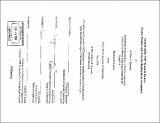Analysis of the MIT research reactor fission product and actinide radioactivity inventories
Author(s)
Kennedy, William B. (William Blake), 1979-
DownloadFull printable version (10.59Mb)
Alternative title
Analysis of the MITR fission product and actinide radioactivity inventories
Other Contributors
Massachusetts Institute of Technology. Dept. of Physics.
Advisor
Mujid Kaximi and Lin-wen Hu.
Terms of use
Metadata
Show full item recordAbstract
The current analysis of the MITR core radioactivity inventory eliminates unnecessary assumptions made in previous estimates of the inventory, and revises the list of contributory isotopes to include all actinide and fission product isotopes necessary for a proper accident source term calculation. The result is a power-history-dependent inventory that increases with bum-up, and comprises 41 actinide isotopes and 596 fission product isotopes. The analysis uses the ORIGEN2 depletion code to calculate the activity of actinide and fission product isotopes for eight MITR input models at 32 intervals over a period of 5376MWD. The input models simulate a MITR core loaded with high- enrichment, U-Alx cermet fuel or low-enrichment, monolithic U-Mo fuel, and operated at 6MW with a continuous-burn-up or cyclic-burn-up-and-decay power history. Reorganization of the ORIGEN2 output file, and application of an element reduction criterion creates the condensed matrix file for each MITR input model. This file lists the contribution of each isotope to the core radioactivity inventory at each output interval, and is the basis for all inventory analysis. The inventory analysis yields three important conclusions. First, the assumption of an equilibrium inventory of isotopes in the fuel is accurate to within 3% for all time after 10% fuel bum-up, and conservative over the entire fuel cycle. The equilibrium fuel assumption is invalid for the actinides due to a slow rate of inventory growth. Second, the cyclic-bum-up-and-decay power history yields a lower core inventory than the continuous-burn-up power history for both fuel enrichments. The difference is minimized by increasing the ratio of irradiation time to decay time. (cont.) Finally, the analysis indicates that conversion to a U-Mo fuel will produce an actinide inventory 18 times greater than that of the current U-Alx fuel, with no significant change in the fission product inventory. However, the actinide inventory is a small fraction of the fission product inventory. The worst-case core inventory available for release is 2.91 E+7Ci for the high-enrichment fuel, and 2.94E+7Ci for the low-enrichment fuel, with a core loading of 24 elements in each case. The best-estimate core inventory available for release is 2.83E+7Ci, and 2.82E+7Ci respectively, and accounts for typical cyclic operation of the MITR.
Description
Thesis (S.B.)--Massachusetts Institute of Technology, Dept. of Physics, 2004. MIT Institute Archives copy: leaves 92-111 bound in reverse order. Includes bibliographical references (leaf 57).
Date issued
2004Department
Massachusetts Institute of Technology. Department of PhysicsPublisher
Massachusetts Institute of Technology
Keywords
Physics.